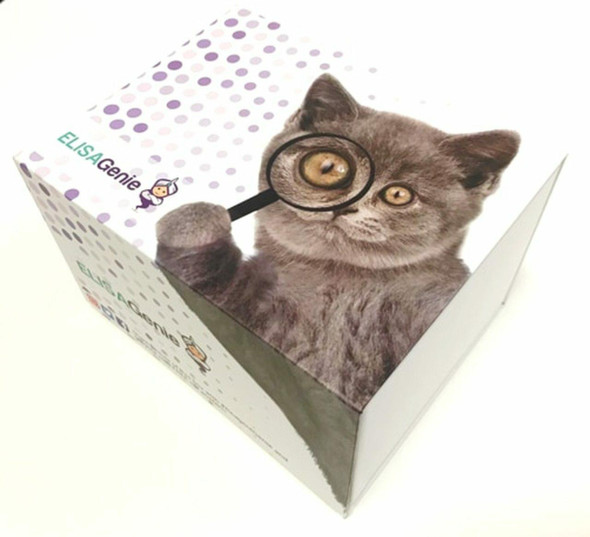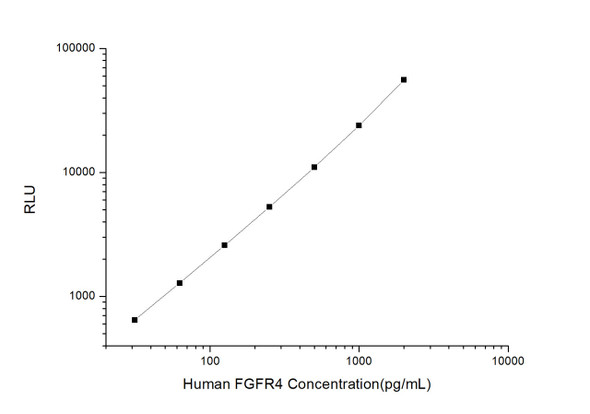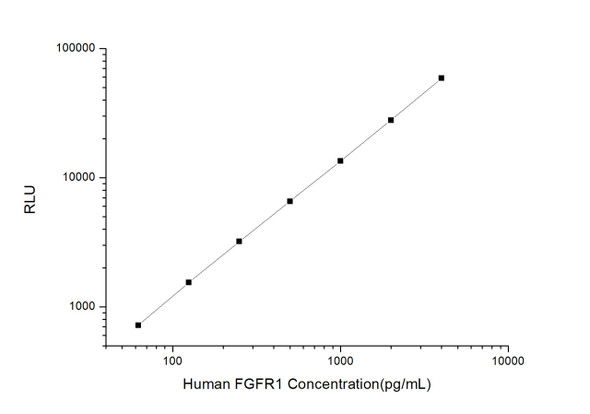Human Cell Death ELISA Kits
Human FGFR2 (Fibroblast Growth Factor Receptor 2) CLIA Kit (HUES00138)
- SKU:
- HUES00138
- Product Type:
- ELISA Kit
- ELISA Type:
- CLIA Kit
- Size:
- 96 Assays
- Sensitivity:
- 7.5pg/mL
- Range:
- 12.5-800pg/mL
- ELISA Type:
- Sandwich
- Synonyms:
- BBDS, BEK, CD332, BFR-1, CEK3, CFD1, ECT1, JWS, K-SAM, KGFR, TK14, TK25
- Reactivity:
- Human
- Sample Type:
- Serum, plasma and other biological fluids
- Research Area:
- Cell Death
Description
| Assay type: | Sandwich |
| Format: | 96T |
| Assay time: | 4.5h |
| Reactivity: | Human |
| Detection method: | Chemiluminescence |
| Detection range: | 12.50-800 pg/mL |
| Sensitivity: | 7.50 pg/mL |
| Sample volume: | 100µL |
| Sample type: | Serum, plasma and other biological fluids |
| Repeatability: | CV < 15% |
| Specificity: | This kit recognizes Human FGFR2 in samples. No significant cross-reactivity or interference between Human FGFR2 and analogues was observed. |
This kit uses Sandwich-CLIA as the method. The micro CLIA plate provided in this kit has been pre-coated with an antibody specific to Human FGFR2. Standards or samples are added to the appropriate micro CLIA plate wells and combined with the specific antibody. Then a biotinylated detection antibody specific for Human FGFR2 and Avidin-Horseradish Peroxidase (HRP) conjugate are added to each micro plate well successively and incubated. Free components are washed away. The substrate solution is added to each well. Only those wells that contain Human FGFR2, biotinylated detection antibody and Avidin-HRP conjugate will appear fluorescence. The Relative light unit (RLU) value is measured spectrophotometrically by the Chemiluminescence immunoassay analyzer. The RLU value is positively associated with the concentration of Human FGFR2. The concentration of Human FGFR2 in the samples can be calculated by comparing the RLU of the samples to the standard curve.
| UniProt Protein Function: | FGFR2: a receptor tyrosine kinase of the highly-conserved FGFR family that binds fibroblast growth factor (FGF). Mutations are associated with many craniosynostotic syndromes and bone malformations. Mutations cause syndromes with defects in facial and limb development, including Crouzon syndrome, Beare-Stevenson cutis gyrata syndrome, Pfeiffer syndrome, Apert syndrome, and Jackson-Weiss syndrome. Somatic mutations seen in gastric cancer. Amplified in gastric, breast and some B cell cancers, but deleted in glioblastoma Twenty splice-variant isoforms have been described. |
| UniProt Protein Details: | Protein type:EC 2. 7. 10. 1; FGFR family; Kinase, protein; Membrane protein, integral; Oncoprotein; Protein kinase, TK; Protein kinase, tyrosine (receptor); TK group Chromosomal Location of Human Ortholog: 10q26. 13 Cellular Component: cell cortex; cell surface; cytoplasm; excitatory synapse; extracellular matrix; integral to plasma membrane; intracellular membrane-bound organelle; nucleoplasm; nucleus; plasma membrane Molecular Function:1-phosphatidylinositol-3-kinase activity; fibroblast growth factor binding; fibroblast growth factor receptor activity; phosphatidylinositol-4,5-bisphosphate 3-kinase activity; protein binding; protein homodimerization activity; protein-tyrosine kinase activity; Ras guanyl-nucleotide exchange factor activity Biological Process: alveolus development; angiogenesis; axonogenesis; bone mineralization; branching morphogenesis of a nerve; cell fate commitment; cell-cell signaling; embryonic cranial skeleton morphogenesis; embryonic digestive tract morphogenesis; embryonic organ development; embryonic organ morphogenesis; embryonic pattern specification; epidermis morphogenesis; epithelial cell differentiation; fibroblast growth factor receptor signaling pathway; gland morphogenesis; gut development; hair follicle morphogenesis; in utero embryonic development; inner ear morphogenesis; lacrimal gland development; limb bud formation; lung development; MAPKKK cascade; mesenchymal cell differentiation; midbrain development; morphogenesis of embryonic epithelium; multicellular organism growth; negative regulation of transcription from RNA polymerase II promoter; neuroblast division in the ventricular zone; odontogenesis; orbitofrontal cortex development; organ growth; organ morphogenesis; otic vesicle formation; peptidyl-tyrosine phosphorylation; phosphoinositide-mediated signaling; positive regulation of cardiac muscle cell proliferation; positive regulation of cell cycle; positive regulation of cell division; positive regulation of cell proliferation; positive regulation of epithelial cell proliferation; positive regulation of MAPKKK cascade; positive regulation of mesenchymal cell proliferation; positive regulation of transcription from RNA polymerase II promoter; positive regulation of Wnt receptor signaling pathway; post-embryonic development; protein amino acid autophosphorylation; pyramidal neuron development; regulation of cell fate commitment; regulation of fibroblast growth factor receptor signaling pathway; regulation of multicellular organism growth; regulation of osteoblast differentiation; regulation of osteoblast proliferation; regulation of phosphoinositide 3-kinase cascade; regulation of smooth muscle cell differentiation; regulation of smoothened signaling pathway; reproductive structure development; skeletal morphogenesis; ureteric bud development; ventricular cardiac muscle morphogenesis Disease: Antley-bixler Syndrome Without Genital Anomalies Or Disordered Steroidogenesis; Apert Syndrome; Beare-stevenson Cutis Gyrata Syndrome; Bent Bone Dysplasia Syndrome; Crouzon Syndrome; Gastric Cancer; Jackson-weiss Syndrome; Lacrimoauriculodentodigital Syndrome; Pfeiffer Syndrome; Saethre-chotzen Syndrome; Scaphocephaly, Maxillary Retrusion, And Mental Retardation |
| NCBI Summary: | The protein encoded by this gene is a member of the fibroblast growth factor receptor family, where amino acid sequence is highly conserved between members and throughout evolution. FGFR family members differ from one another in their ligand affinities and tissue distribution. A full-length representative protein consists of an extracellular region, composed of three immunoglobulin-like domains, a single hydrophobic membrane-spanning segment and a cytoplasmic tyrosine kinase domain. The extracellular portion of the protein interacts with fibroblast growth factors, setting in motion a cascade of downstream signals, ultimately influencing mitogenesis and differentiation. This particular family member is a high-affinity receptor for acidic, basic and/or keratinocyte growth factor, depending on the isoform. Mutations in this gene are associated with Crouzon syndrome, Pfeiffer syndrome, Craniosynostosis, Apert syndrome, Jackson-Weiss syndrome, Beare-Stevenson cutis gyrata syndrome, Saethre-Chotzen syndrome, and syndromic craniosynostosis. Multiple alternatively spliced transcript variants encoding different isoforms have been noted for this gene. [provided by RefSeq, Jan 2009] |
| UniProt Code: | P21802 |
| NCBI GenInfo Identifier: | 120049 |
| NCBI Gene ID: | 2263 |
| NCBI Accession: | P21802. 1 |
| UniProt Secondary Accession: | P21802,P18443, Q01742, Q12922, Q14300, Q14301, Q14302 Q14303, Q14304, B4DFC2, E7EVR6, E9PCR0, |
| UniProt Related Accession: | P21802 |
| Molecular Weight: | 79,833 Da |
| NCBI Full Name: | Fibroblast growth factor receptor 2 |
| NCBI Synonym Full Names: | fibroblast growth factor receptor 2 |
| NCBI Official Symbol: | FGFR2 |
| NCBI Official Synonym Symbols: | BEK; JWS; BBDS; CEK3; CFD1; ECT1; KGFR; TK14; TK25; BFR-1; CD332; K-SAM |
| NCBI Protein Information: | fibroblast growth factor receptor 2 |
| UniProt Protein Name: | Fibroblast growth factor receptor 2 |
| UniProt Synonym Protein Names: | K-sam; KGFR; Keratinocyte growth factor receptor; CD_antigen: CD332 |
| Protein Family: | Tumor necrosis factor receptor superfamily |
| UniProt Gene Name: | FGFR2 |
As the RLU values of the standard curve may vary according to the conditions of the actual assay performance (e. g. operator, pipetting technique, washing technique or temperature effects), the operator should establish a standard curve for each test. Typical standard curve and data is provided below for reference only.
| Concentration (pg/mL) | RLU | Average | Corrected |
| 800 | 52043 53241 | 52642 | 52616 |
| 400 | 21008 22460 | 21734 | 21708 |
| 200 | 10354 9062 | 9708 | 9682 |
| 100 | 4392 4712 | 4552 | 4526 |
| 50 | 2260 2116 | 2188 | 2162 |
| 25 | 1130 990 | 1060 | 1034 |
| 12.50 | 474 544 | 509 | 483 |
| 0 | 26 26 | 26 | -- |
Precision
Intra-assay Precision (Precision within an assay): 3 samples with low, mid range and high level Human FGFR2 were tested 20 times on one plate, respectively.
Inter-assay Precision (Precision between assays): 3 samples with low, mid range and high level Human FGFR2 were tested on 3 different plates, 20 replicates in each plate.
| Intra-assay Precision | Inter-assay Precision | |||||
| Sample | 1 | 2 | 3 | 1 | 2 | 3 |
| n | 20 | 20 | 20 | 20 | 20 | 20 |
| Mean (pg/mL) | 42.85 | 96.80 | 304.95 | 42.49 | 101.07 | 276.84 |
| Standard deviation | 3.66 | 7.18 | 19.79 | 4.97 | 8.48 | 18.66 |
| C V (%) | 8.54 | 7.42 | 6.49 | 11.70 | 8.39 | 6.74 |
Recovery
The recovery of Human FGFR2 spiked at three different levels in samples throughout the range of the assay was evaluated in various matrices.
| Sample Type | Range (%) | Average Recovery (%) |
| Serum (n=5) | 94-105 | 99 |
| EDTA plasma (n=5) | 91-103 | 97 |
| Cell culture media (n=5) | 91-101 | 96 |
Linearity
Samples were spiked with high concentrations of Human FGFR2 and diluted with Reference Standard & Sample Diluent to produce samples with values within the range of the assay.
| Serum (n=5) | EDTA plasma (n=5) | Cell culture media (n=5) | ||
| 1:2 | Range (%) | 100-115 | 94-109 | 101-120 |
| Average (%) | 108 | 101 | 109 | |
| 1:4 | Range (%) | 98-116 | 89-99 | 93-108 |
| Average (%) | 106 | 94 | 99 | |
| 1:8 | Range (%) | 97-109 | 89-103 | 89-103 |
| Average (%) | 103 | 96 | 95 | |
| 1:16 | Range (%) | 95-109 | 92-103 | 97-113 |
| Average (%) | 101 | 97 | 105 |
An unopened kit can be stored at 4°C for 1 month. If the kit is not used within 1 month, store the items separately according to the following conditions once the kit is received.
| Item | Specifications | Storage |
| Micro CLIA Plate(Dismountable) | 8 wells ×12 strips | -20°C, 6 months |
| Reference Standard | 2 vials | |
| Concentrated Biotinylated Detection Ab (100×) | 1 vial, 120 µL | |
| Concentrated HRP Conjugate (100×) | 1 vial, 120 µL | -20°C(shading light), 6 months |
| Reference Standard & Sample Diluent | 1 vial, 20 mL | 4°C, 6 months |
| Biotinylated Detection Ab Diluent | 1 vial, 14 mL | |
| HRP Conjugate Diluent | 1 vial, 14 mL | |
| Concentrated Wash Buffer (25×) | 1 vial, 30 mL | |
| Substrate Reagent A | 1 vial, 5 mL | 4°C (shading light) |
| Substrate Reagent B | 1 vial, 5 mL | 4°C (shading light) |
| Plate Sealer | 5 pieces | |
| Product Description | 1 copy | |
| Certificate of Analysis | 1 copy |
- Set standard, test sample and control (zero) wells on the pre-coated plate and record theirpositions. It is recommended to measure each standard and sample in duplicate. Note: addall solutions to the bottom of the plate wells while avoiding contact with the well walls. Ensuresolutions do not foam when adding to the wells.
- Aliquot 100µl of standard solutions into the standard wells.
- Add 100µl of Sample / Standard dilution buffer into the control (zero) well.
- Add 100µl of properly diluted sample (serum, plasma, tissue homogenates and otherbiological fluids. ) into test sample wells.
- Cover the plate with the sealer provided in the kit and incubate for 90 min at 37°C.
- Aspirate the liquid from each well, do not wash. Immediately add 100µL of BiotinylatedDetection Ab working solution to each well. Cover the plate with a plate seal and gently mix. Incubate for 1 hour at 37°C.
- Aspirate or decant the solution from the plate and add 350µL of wash buffer to each welland incubate for 1-2 minutes at room temperature. Aspirate the solution from each well andclap the plate on absorbent filter paper to dry. Repeat this process 3 times. Note: a microplatewasher can be used in this step and other wash steps.
- Add 100µL of HRP Conjugate working solution to each well. Cover with a plate seal andincubate for 30 min at 37°C.
- Aspirate or decant the solution from each well. Repeat the wash process for five times asconducted in step 7.
- Add 100µL of Substrate mixture solution to each well. Cover with a new plate seal andincubate for no more than 5 min at 37°C. Protect the plate from light.
- Determine the RLU value of each well immediately.






